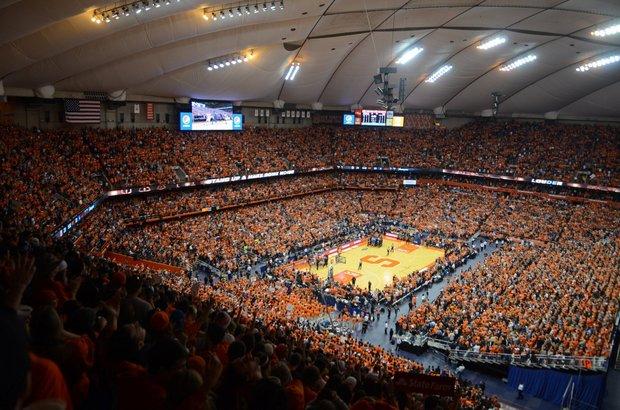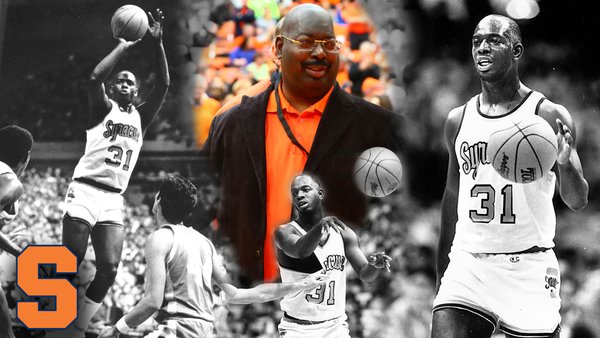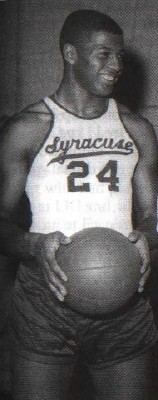SWC75
Bored Historian
- Joined
- Aug 26, 2011
- Messages
- 34,011
- Like
- 65,639
A few weeks ago we had a thread in which somebody said "Jim Boeheim built this program up from nothing". Now we are hearing that nothing that the Syracuse program became was possible without pearl Washington, or that it all began with him, that he was our most important recruit ever, etc. etc. I think some historical perspective is needed.
We have quite a history in the sport. Only four schools ahve won more games in their history:
https://en.wikipedia.org/wiki/List_...s_in_NCAA_Division_I_men's_college_basketball
We have two Helms National Championships, (both confirmed by the better- researched Premo-Poretta Poll:
https://en.wikipedia.org/wiki/Premo-Porretta_Power_Poll
...which also has us #6 in 1905, #8 in 1906 and 1908#10 in 1912#2 in 1914, #8 in 1915, #6 in 1925 and #3 in 1930. We were an important part of the early history of the game.
As the 1930's went on we continued to have good teams but were not as highly regarded. After the war we continued to be good, going to our first NIT, (the NCAA tournament only invited 8 teams) in 1946 with a 23-4 record. . We had 13 winning seasons in 15 years from 1946-60.
But until the 1960's, basketball was still a minor, or at least a lesser sport compared to the one sport people really cared about: football. It was what I call a "gymnasium sport", played in places like Archbold Gym, complete with balcony seating and pull-out bleachers. Here's a shot of old Archie when they held a boxing match there, but it shows what the basketball court looked like:

Also, after the war, SU basketball was basically what LeMoyne is today and the Nats where what SU is today: the team that put us on the map, that tells the nation we are here. Nobody really cared that much about what SU did in the old, old days.
Late in that period, it got worse than that. Marc Guley, the basketball coach had two problems: he adhered to the old notion that you shouldn't have a majority of players on the court being back, which cost him the services of Jim Brown, (and who knows who else). I've also heard that he had an alcohol problem. The basketball program declined to the point where it was basically being used by football players as a means of staying in shape in the off-season.

The result was an awful two year run in 1961-62 when we went 4-19 and then 2-22, including a national record 27 game losing streak. That’s when we were “nothing”.
It is ironic that two buildings built primarily for the football program did even more for the basketball program. Manley Field House was our original IPF. The University decided that the expense would be better justified if we used it for other sports as well and that a revived basketball program would be a big part of that. So they hired Fred Lewis who managed to recruit Dave Bing who was certainly our most important recruit ever. It’s certainly true that everything that’s happened since Dave Bing came here could not have happened without him – or at least it would have been a much longer and more uncertain road. (It also helped that the Nats left town and SU basketball became the vessel of our hopes.)
In four years we went from the worst team in the country to the highest scoring team in history. It should have continued on from there as our recruiting remained strong but some academic and legal problems tore the roster part and some internal dissension resulted in Lewis being canned. But he and Bing, (with Jim Boeheim’s help), had gotten things started.
Roy Danforth didn’t have to build the program from scratch but he did pick up the pieces and molded winning teams from them. We got gradually better until 20 win seasons, (when we were playing less than 30 games) were routine. Thanks to a big upset over North Carolina and a couple of miracle wins over LaSalle and Kansas State, we made it to the Final Four in 1975. A decade after Bing, it was another flair sent up that put us on the national scene, if briefly.
It shows the level of prestige of the program that Danforth, (who was from the south) saw the job as a stepping stone to a job he really wanted: coaching Tulane in the Superdome. It was at this point that Jim Boeheim took over as head coach. He took over a respected regional program that was capable of occasionally making some noise nationally. What we’d lacked was good big men, (thus “Roy’s Runts”). Jim and his first hire, Rick Pitino, went out and got Roosevelt Bouie and Louie Orr and when he beat Louisville at Louisville in his fourth game, it became clear that things had changed. For the next four years we had the personnel to beat anyone. We could never break through in the NCAA tournament, (as in this decade, the wrong team made the Final Four), but we became a national power for the first time, rising as high as #2 in the Polls in L-B’s senior year.
Just as they departed, the Carrier Dome was finally built and ready to open. It was also built to revive the football program but ultimately meant more to the basketball program. We suddenly had the largest arena in the country. Manley had 9,500 seats. Our attendance the first year at the Dome was 16,440. It was part of a fortuitous confluence of events that would turn SU basketball into an institution. Boeheim, building on the foundation created by his predecessors, the opening of the Dome, the creation of the Big East and of ESPN to showcase it all contributed strongly.

But we still weren’t what we would become. In the “Tri-captains Era” (Rautins-Santifer-Bruin), we returned to being pretty good but not great. For years Jim Boeheim said the one recruiting battle he regretted losing the most was for Albany’s Sam Perkins who went to UNC, (because they gave his girlfriend a scholarship, I’ve heard), and joined Michael Jordan and James Worthy to contend for national championships. With him in the middle the Tri-captains teams could have bene as strong as the Louie-Bouie teams. It left the impression that the L-B Era was just that- an era. Would we ever get back to that level again?
One thing we’d never been able to do was to recruit New York City effectively. Most of our players were from Upstate New York , New England or Pennsylvania. The top NYC guys went to the ACC or maybe out to Wisconsin to play for Al McGuire or to California to play for UCLA. We needed to become a national recruiter and a player for the top talent. That’s why it was such a big thing when New York City legend and #1 national recruit Dwayne “Pearl” Washington told McGuire, (now a commentator who might have recruited Pearl himself had he still been a coach) on national TV that he was coming to Syracuse. That had never happened before. I don’t know what Dave Bing was ranked back in 1962 or even if they had rankings back then, (he was a High School All-American). To have a #1 national recruit even consider us had never happened before and it was an indication of how far we had come.
Attendance at the Dome went from 20,401 the year before the Pearl to 22,380 his freshman year to 25,870 as a sophomore and 26,255 as a junior. After he left, even with all the success of the 1986-87 season, attendance went down to 24,959. Then, after we went to the title game, it shot up further to 28,826 and stated at that level through Billy owns junior year in 1990-91, with a peak of 29,919. It hen steadily declined all the way to 17,023 in 2001-02. With Carmelo it then jumped back up to 20,921 and has remained above 20,000 since, with a peak of 26,253 in 2013-14 when we had that 25-0 start.
I think the subsequent success would have happened if Pearl had gone elsewhere. The forces that were creating it: Boeheim, the Dome, ESPN and the Big East, would have made it happen. But he was the pilot light that lighted the flame.

We have quite a history in the sport. Only four schools ahve won more games in their history:
https://en.wikipedia.org/wiki/List_...s_in_NCAA_Division_I_men's_college_basketball
We have two Helms National Championships, (both confirmed by the better- researched Premo-Poretta Poll:
https://en.wikipedia.org/wiki/Premo-Porretta_Power_Poll
...which also has us #6 in 1905, #8 in 1906 and 1908#10 in 1912#2 in 1914, #8 in 1915, #6 in 1925 and #3 in 1930. We were an important part of the early history of the game.
As the 1930's went on we continued to have good teams but were not as highly regarded. After the war we continued to be good, going to our first NIT, (the NCAA tournament only invited 8 teams) in 1946 with a 23-4 record. . We had 13 winning seasons in 15 years from 1946-60.
But until the 1960's, basketball was still a minor, or at least a lesser sport compared to the one sport people really cared about: football. It was what I call a "gymnasium sport", played in places like Archbold Gym, complete with balcony seating and pull-out bleachers. Here's a shot of old Archie when they held a boxing match there, but it shows what the basketball court looked like:

Also, after the war, SU basketball was basically what LeMoyne is today and the Nats where what SU is today: the team that put us on the map, that tells the nation we are here. Nobody really cared that much about what SU did in the old, old days.
Late in that period, it got worse than that. Marc Guley, the basketball coach had two problems: he adhered to the old notion that you shouldn't have a majority of players on the court being back, which cost him the services of Jim Brown, (and who knows who else). I've also heard that he had an alcohol problem. The basketball program declined to the point where it was basically being used by football players as a means of staying in shape in the off-season.

The result was an awful two year run in 1961-62 when we went 4-19 and then 2-22, including a national record 27 game losing streak. That’s when we were “nothing”.
It is ironic that two buildings built primarily for the football program did even more for the basketball program. Manley Field House was our original IPF. The University decided that the expense would be better justified if we used it for other sports as well and that a revived basketball program would be a big part of that. So they hired Fred Lewis who managed to recruit Dave Bing who was certainly our most important recruit ever. It’s certainly true that everything that’s happened since Dave Bing came here could not have happened without him – or at least it would have been a much longer and more uncertain road. (It also helped that the Nats left town and SU basketball became the vessel of our hopes.)
In four years we went from the worst team in the country to the highest scoring team in history. It should have continued on from there as our recruiting remained strong but some academic and legal problems tore the roster part and some internal dissension resulted in Lewis being canned. But he and Bing, (with Jim Boeheim’s help), had gotten things started.
Roy Danforth didn’t have to build the program from scratch but he did pick up the pieces and molded winning teams from them. We got gradually better until 20 win seasons, (when we were playing less than 30 games) were routine. Thanks to a big upset over North Carolina and a couple of miracle wins over LaSalle and Kansas State, we made it to the Final Four in 1975. A decade after Bing, it was another flair sent up that put us on the national scene, if briefly.
It shows the level of prestige of the program that Danforth, (who was from the south) saw the job as a stepping stone to a job he really wanted: coaching Tulane in the Superdome. It was at this point that Jim Boeheim took over as head coach. He took over a respected regional program that was capable of occasionally making some noise nationally. What we’d lacked was good big men, (thus “Roy’s Runts”). Jim and his first hire, Rick Pitino, went out and got Roosevelt Bouie and Louie Orr and when he beat Louisville at Louisville in his fourth game, it became clear that things had changed. For the next four years we had the personnel to beat anyone. We could never break through in the NCAA tournament, (as in this decade, the wrong team made the Final Four), but we became a national power for the first time, rising as high as #2 in the Polls in L-B’s senior year.
Just as they departed, the Carrier Dome was finally built and ready to open. It was also built to revive the football program but ultimately meant more to the basketball program. We suddenly had the largest arena in the country. Manley had 9,500 seats. Our attendance the first year at the Dome was 16,440. It was part of a fortuitous confluence of events that would turn SU basketball into an institution. Boeheim, building on the foundation created by his predecessors, the opening of the Dome, the creation of the Big East and of ESPN to showcase it all contributed strongly.

But we still weren’t what we would become. In the “Tri-captains Era” (Rautins-Santifer-Bruin), we returned to being pretty good but not great. For years Jim Boeheim said the one recruiting battle he regretted losing the most was for Albany’s Sam Perkins who went to UNC, (because they gave his girlfriend a scholarship, I’ve heard), and joined Michael Jordan and James Worthy to contend for national championships. With him in the middle the Tri-captains teams could have bene as strong as the Louie-Bouie teams. It left the impression that the L-B Era was just that- an era. Would we ever get back to that level again?
One thing we’d never been able to do was to recruit New York City effectively. Most of our players were from Upstate New York , New England or Pennsylvania. The top NYC guys went to the ACC or maybe out to Wisconsin to play for Al McGuire or to California to play for UCLA. We needed to become a national recruiter and a player for the top talent. That’s why it was such a big thing when New York City legend and #1 national recruit Dwayne “Pearl” Washington told McGuire, (now a commentator who might have recruited Pearl himself had he still been a coach) on national TV that he was coming to Syracuse. That had never happened before. I don’t know what Dave Bing was ranked back in 1962 or even if they had rankings back then, (he was a High School All-American). To have a #1 national recruit even consider us had never happened before and it was an indication of how far we had come.
Attendance at the Dome went from 20,401 the year before the Pearl to 22,380 his freshman year to 25,870 as a sophomore and 26,255 as a junior. After he left, even with all the success of the 1986-87 season, attendance went down to 24,959. Then, after we went to the title game, it shot up further to 28,826 and stated at that level through Billy owns junior year in 1990-91, with a peak of 29,919. It hen steadily declined all the way to 17,023 in 2001-02. With Carmelo it then jumped back up to 20,921 and has remained above 20,000 since, with a peak of 26,253 in 2013-14 when we had that 25-0 start.
I think the subsequent success would have happened if Pearl had gone elsewhere. The forces that were creating it: Boeheim, the Dome, ESPN and the Big East, would have made it happen. But he was the pilot light that lighted the flame.


